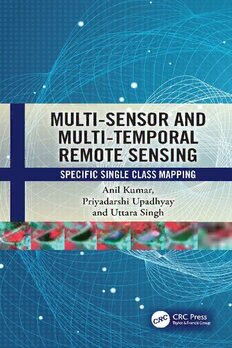Download MultiSensor and MultiTemporal Remote Sensing PDF Free - Full Version
Download MultiSensor and MultiTemporal Remote Sensing by Anil Kumar, Priyadarshi Upadhyay, Uttara Singh in PDF format completely FREE. No registration required, no payment needed. Get instant access to this valuable resource on PDFdrive.to!
About MultiSensor and MultiTemporal Remote Sensing
This book elaborates fuzzy Machine Learning and Deep Learning models for single class mapping from multi-sensor, multi-temporal remote sensing images while handling mixed pixels and noise. It also covers the ways of pre-processing and spectral dimensionality reduction of temporal data. Further, it discusses the ‘individual sample as mean’ training approach to handle heterogeneity within a class. The appendix section of the book includes case studies such as mapping crop type, forest species, and stubble burnt paddy fields.There are numerous Machine Learning models available for use in a variety of applications. Machine Learning classifers can fall into statistical categories such as c-Means, maximum-likelihood classifers, and decision-tree categories, such as random forest and Classifcation and Regression Tree (CART). Fuzzy c-Means (FCM), Possibilistic c-Means (PCM), Noise Clustering (NC), and Modifed Possibilistic c-Means (MPCM) are examples of fuzzy-logic algorithms. The Machine Learning model should be chosen in such a way that it can deal with mixed pixels, non-linearity between classes, and noisy pixels. Machine Learning models should be able to map a single class of interest, which has a wide range of applications, where only one class of interest needs to be mapped from remote-sensing data. Machine Learning models should also be able to deal with heterogeneity within classes, which is caused by the fact that training data for each class is not homogeneous. So, in this section, fuzzy classifers are discussed, which addresses the raised concerns. In this chapter, mathematical formulas and algorithms of the fuzzy-based algorithms have been explained. The description starts with Fuzzy c-Means (FCM), moves on to Possibilistic c-Means (PCM) and Noise Clustering, and then Modifed Possibilistic c-Means (MPCM) is described.Key features:Focuses on use of multi-sensor, multi-temporal data while handling spectral overlap between classesDiscusses range of fuzzy/deep learning models capable to extract specific single class and separates noiseDescribes pre-processing while using spectral, textural, CBSI indices, and back scatter coefficient/Radar Vegetation Index (RVI)Discusses the role of training data to handle the heterogeneity within a classSupports multi-sensor and multi-temporal data processing through in-house SMIC softwareIncludes case studies and practical applications for single class mappingThis book is intended for graduate/postgraduate students, research scholars, and professionals working in environmental, geography, Computer Sciences, remote sensing, geoinformatics, forestry, agriculture, post-disaster, urban transition studies, and other related areas.
Detailed Information
| Author: | Anil Kumar, Priyadarshi Upadhyay, Uttara Singh |
|---|---|
| Publication Year: | 2023 |
| ISBN: | 9781003373216 |
| Pages: | 178 |
| Language: | English |
| File Size: | 9.35 |
| Format: | |
| Price: | FREE |
Safe & Secure Download - No registration required
Why Choose PDFdrive for Your Free MultiSensor and MultiTemporal Remote Sensing Download?
- 100% Free: No hidden fees or subscriptions required for one book every day.
- No Registration: Immediate access is available without creating accounts for one book every day.
- Safe and Secure: Clean downloads without malware or viruses
- Multiple Formats: PDF, MOBI, Mpub,... optimized for all devices
- Educational Resource: Supporting knowledge sharing and learning
Frequently Asked Questions
Is it really free to download MultiSensor and MultiTemporal Remote Sensing PDF?
Yes, on https://PDFdrive.to you can download MultiSensor and MultiTemporal Remote Sensing by Anil Kumar, Priyadarshi Upadhyay, Uttara Singh completely free. We don't require any payment, subscription, or registration to access this PDF file. For 3 books every day.
How can I read MultiSensor and MultiTemporal Remote Sensing on my mobile device?
After downloading MultiSensor and MultiTemporal Remote Sensing PDF, you can open it with any PDF reader app on your phone or tablet. We recommend using Adobe Acrobat Reader, Apple Books, or Google Play Books for the best reading experience.
Is this the full version of MultiSensor and MultiTemporal Remote Sensing?
Yes, this is the complete PDF version of MultiSensor and MultiTemporal Remote Sensing by Anil Kumar, Priyadarshi Upadhyay, Uttara Singh. You will be able to read the entire content as in the printed version without missing any pages.
Is it legal to download MultiSensor and MultiTemporal Remote Sensing PDF for free?
https://PDFdrive.to provides links to free educational resources available online. We do not store any files on our servers. Please be aware of copyright laws in your country before downloading.
The materials shared are intended for research, educational, and personal use in accordance with fair use principles.

